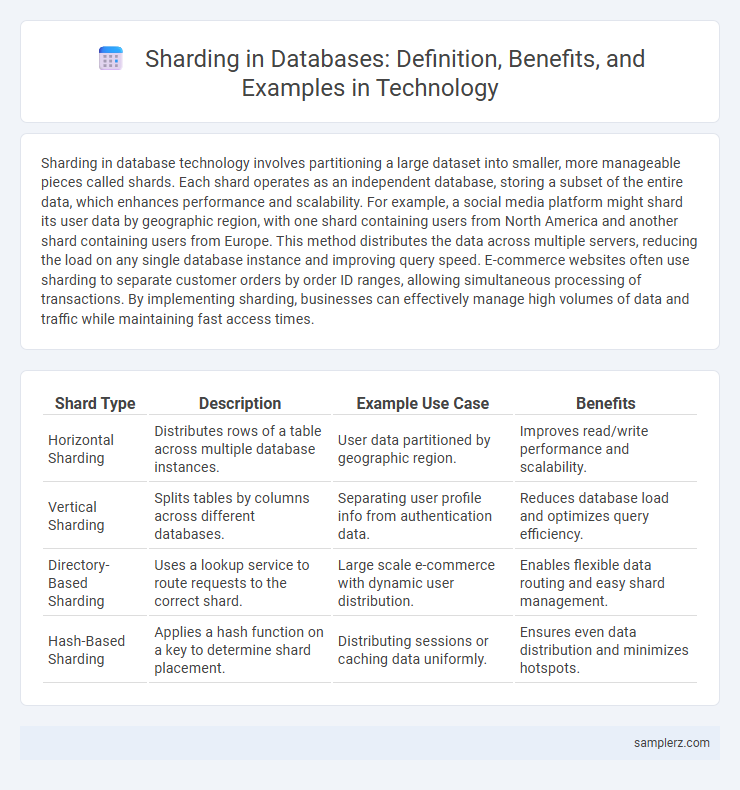Sharding in database technology involves partitioning a large dataset into smaller, more manageable pieces called shards. Each shard operates as an independent database, storing a subset of the entire data, which enhances performance and scalability. For example, a social media platform might shard its user data by geographic region, with one shard containing users from North America and another shard containing users from Europe. This method distributes the data across multiple servers, reducing the load on any single database instance and improving query speed. E-commerce websites often use sharding to separate customer orders by order ID ranges, allowing simultaneous processing of transactions. By implementing sharding, businesses can effectively manage high volumes of data and traffic while maintaining fast access times.
Table of Comparison
| Shard Type | Description | Example Use Case | Benefits |
|---|---|---|---|
| Horizontal Sharding | Distributes rows of a table across multiple database instances. | User data partitioned by geographic region. | Improves read/write performance and scalability. |
| Vertical Sharding | Splits tables by columns across different databases. | Separating user profile info from authentication data. | Reduces database load and optimizes query efficiency. |
| Directory-Based Sharding | Uses a lookup service to route requests to the correct shard. | Large scale e-commerce with dynamic user distribution. | Enables flexible data routing and easy shard management. |
| Hash-Based Sharding | Applies a hash function on a key to determine shard placement. | Distributing sessions or caching data uniformly. | Ensures even data distribution and minimizes hotspots. |
What is Sharding in Databases?
Sharding in databases is a method of partitioning large datasets across multiple servers, which enhances performance and scalability by distributing the load. Each shard contains a subset of the data, often based on a specific key, allowing parallel processing and faster query responses. This approach is commonly used in systems like MongoDB and Apache Cassandra to manage vast amounts of data efficiently.
Benefits of Database Sharding
Database sharding enhances system scalability by distributing data across multiple servers, reducing the load on any single database instance. It improves query performance and reduces latency by enabling parallel processing of requests on separate shards. Sharding also increases fault tolerance, as issues in one shard do not affect the entire database, ensuring higher availability and resilience.
Types of Sharding Techniques
Horizontal sharding partitions database rows across multiple tables or servers, enhancing scalability by distributing data based on key values such as user ID ranges. Vertical sharding divides tables by columns, isolating different data attributes to optimize query performance and manage specialized workloads. Directory-based sharding uses a lookup service to map data to shards dynamically, providing flexibility and balance in distributed database architectures.
Real-World Sharding: MongoDB Examples
MongoDB employs sharding to distribute large datasets across multiple servers, enhancing scalability and performance in real-time applications. Each shard in MongoDB holds a subset of the database's data, determined by a shard key such as user ID or geographic location, enabling efficient query routing and load balancing. This approach allows enterprises like e-commerce platforms and social networks to manage high-volume transactions while maintaining low latency and high availability.
Sharding in SQL Databases: A Use Case
Sharding in SQL databases involves splitting a large database into smaller, more manageable pieces called shards, each hosted on separate servers to enhance performance and scalability. An example use case is an e-commerce platform handling millions of transactions daily, where customer data is partitioned by geographic regions to reduce query latency and evenly distribute the load. This approach allows queries to execute in parallel across shards, improving response times and supporting high availability in distributed database systems.
Vertical vs. Horizontal Sharding Examples
Vertical sharding splits a database by separating tables based on functionality, such as isolating user profile data from transaction records to optimize query performance. Horizontal sharding partitions data within a table across multiple machines by user ID ranges or geographic regions, enabling scalable read and write operations. Companies like Instagram use horizontal sharding to distribute user data across servers, while vertical sharding is common in enterprise systems separating authentication from analytics databases.
Example: Sharding in E-commerce Platforms
E-commerce platforms implement sharding to distribute user and transaction data across multiple database servers, enhancing performance and scalability. For instance, customer orders can be partitioned by geographic region, allowing faster query response times and reducing server load during peak shopping periods. This database sharding strategy ensures seamless user experiences and supports large-scale operations efficiently.
Handling Failures in Sharded Databases
In sharded databases, handling failures involves implementing strategies such as data replication and consensus algorithms like Raft or Paxos to ensure data consistency and availability across shards. Automatic failover mechanisms detect shard or node failures, redirecting queries to healthy replicas to maintain uninterrupted operations. Distributed transaction protocols and partition tolerance measures further enhance the system's resilience by managing concurrency and mitigating data loss during network partitions or hardware faults.
Performance Impact: Before and After Sharding
Sharding a database splits data into smaller, manageable pieces called shards, significantly improving query performance by distributing the load across multiple servers. Before sharding, large monolithic databases often suffer from slow response times and bottlenecks due to high read/write concurrency. After implementing sharding, systems experience reduced latency and enhanced scalability, allowing faster data retrieval and better handling of massive traffic volumes in distributed environments.
Best Practices for Implementing Sharding
Implementing sharding in databases requires careful planning of shard keys to ensure even data distribution and minimal cross-shard queries, enhancing performance and scalability. It is crucial to maintain shard key consistency and automate data rebalancing processes to handle growing datasets smoothly. Monitoring shard health and employing backup strategies for each shard contribute to maintaining data integrity and system resilience.

example of sharding in database Infographic
 samplerz.com
samplerz.com